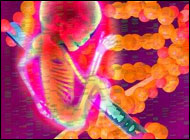Environmental Toxin Causes Heritable Adult-Onset Diseases
A disease you are suffering today could be a result of your great-grandmother being exposed to an environmental toxin during pregnancy - and you may already have passed it along to your children.
That’s the conclusion reached by researchers at Washington State University, who have found that exposure to an environmental toxin during embryonic development can cause an animal, and almost all of its descendents, to develop adult-onset illnesses such as cancer and kidney disease. Their discovery suggests that toxins may have played a role in the rapid increase in localized geographic areas of diseases that were previously thought to be caused primarily by genetic mutations.
“It’s a new way to think about disease,” said Michael K. Skinner, director of the Center for Reproductive Biology. “If this pans out, it gives us a host of new diagnostic and therapeutic tools.” He said it also underscores the potential long-term hazards of environmental contaminants.
The work is reported in two papers in the September 14 issue of the journal Endocrinology. It builds on the group’s 2005 finding that exposure to a toxin during embryonic development can cause fertility problems in male rats that are passed to later generations.
In the current study, Skinner and a team of WSU researchers exposed pregnant rats to an environmental toxin during the period that the sex of their offspring was being determined. At that stage of development, the genes of the male embryo’s sex cells (future sperm) are uniquely vulnerable to reprogramming. 
The researchers used vinclozolin, a fungicide commonly used in vineyards. Vinclozolin belongs to the class of compounds called endocrine disruptors, synthetic chemicals that interfere with the normal functioning of reproductive hormones. Skinner’s group used higher levels of the toxin than are normally present in the environment, but their study raises concerns about the long-term impacts of such toxins on human and animal health, particularly in exposures during early- to mid-pregnancy (6 weeks to 5 months in humans). Further work will be needed to determine whether lower levels have similar effects.
Pregnant rats that were exposed to vinclozolin produced male offspring with low sperm counts and a high incidence of adult-onset diseases. Despite their low fertility, those males were still able to produce offspring. When they were mated with females that had not been exposed to the toxins, their offspring had the same problems. The effect persisted through four generations, with about 85 percent of the offspring in each generation developing conditions such as breast tumors, prostate disease, kidney disease, immune system abnormalities, and premature aging. Some mice came down with just one disease, but the majority suffered multiple ailments.
“Only the original generation mother was exposed to the environmental toxicant,” said Skinner. “A human analogy would be if your grandmother was exposed to an environmental toxicant during mid-gestation, you may develop a disease state even though you never had direct exposure, and you may pass it on to your great-grandchildren.”
The study shows the potential impact of so-called epigenetic inheritance, which refers to the transmission from parent to offspring of biological information that is not encoded in the DNA sequence. Instead, the information stems from small chemicals, such as methyl groups, that become attached to the DNA. In epigenetic transmission, the DNA sequences - the genes - remain the same, but the chemical modifications change the way the genes work and when they “turn on” and “turn off.”
The team identified 25 segments of DNA in the affected rats that had altered patterns of methyl groups compared to control rats. Their results suggest the genes controlling susceptibility to the observed diseases lie somewhere within those 25 segments. Skinner said the broad-spectrum effect of the changes, causing diseases in many organ systems, was a notable result that could provide valuable clues about how diseases develop.
According to Skinner, such changes might play a role in human diseases such as breast cancer and prostate disease, whose frequency is increasing faster than would be expected if they were the result of genetic mutations alone. Scientists have long known about epigenetic changes, but their high rate of heritability and their importance in the control of gene activity were not appreciated until recently.
Skinner said the finding that an environmental toxin can permanently reprogram a heritable trait also may alter our concept of evolutionary biology. Traditional evolutionary theory maintains that the environment is primarily a backdrop on which selection takes place, and that differences between individuals arise from random mutations in the DNA. The work by Skinner and his group raises the possibility that environmental factors may play a much larger role in evolution than has been realized before.
This research was supported by a grant to Skinner from the National Institutes of Health.
Source: Washington State University
Revision date: June 20, 2011
Last revised: by Janet A. Staessen, MD, PhD